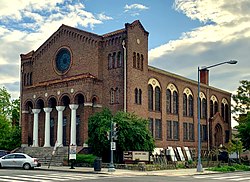| Lincoln Industrial Mission- Lincoln Memorial Congregational Church | |
| U.S. National Register of Historic Places | |
| U.S. Historic district Contributing property | |
 Lincoln Temple United Church of Christ in 2023 Lincoln Temple United Church of Christ in 2023 | |
 | |
| Location | 1701 11th St., NW Washington, D.C. |
|---|---|
| Coordinates | 38°54′47″N 77°1′36″W / 38.91306°N 77.02667°W / 38.91306; -77.02667 |
| Built | 1928 |
| Architect | Howard Wright Cutler |
| Part of | Greater U Street Historic District (ID93001129) |
| NRHP reference No. | 95000163 |
| Added to NRHP | February 24, 1995 |
Lincoln Temple United Church of Christ was a congregation of the United Church of Christ located since 1880 in the Shaw neighborhood in the Northwest Quadrant of Washington, D.C. The original congregation established as Lincoln Memorial Congregational Church. A church building was completed in 1928 and is a historic structure that was listed on the National Register of Historic Places in 1995. The church is also listed on the city's African-American Heritage Trail.
Due to changing demographics in the neighborhood, the church membership declined. It held its final service on September 30, 2018.
History
The congregation can trace its roots to the Lincoln Industrial Mission, which was founded as an educational and social aid mission after the American Civil War. The mission was built on this site in 1868-1869.
In 1880 ten members of First Congregational Church established Lincoln Memorial Congregational Church at the mission. The congregation merged with Park Temple Congregational Church in 1901, and they took the present name.
The American Negro Academy (ANA), the first major African-American learned society in the United States, was formed by the Rev. Alexander Crummell and other intellectuals in 1897. It held its inaugural address in the church.
Walter B. Hayson, one of the founders of the ANA and a protege of Crummell, directed the choir. Notable 20th-century musicians such as Jessye Norman, Marian Anderson and Roberta Flack have sung at the church. Preachers and scholars such as Julian Bond and Jeremiah A. Wright, Jr. have spoken from its pulpit.
Many in the congregation were active during the civil rights era. The church allowed people attending the August 1963 March on Washington for Jobs and Freedom to camp out in the church's auditorium. The church distributed clothes and food to people in the neighborhood during the riots that followed the April 1968 assassination of Martin Luther King Jr. in Memphis. Its leaders had been active in the civil rights movement and working on social justice issues in the capital. For example, minister Channing Emery Phillips was also active in the Coalition of Conscience in D.C. He served as president of the Housing Development Corporation and supported full home-rule status for the District of Columbia.
Because of the church's long significance in the District of Columbia, it has been listed as a site on the city's African-American Heritage Trail.
Final years
The Washington Post cites retirement of its longtime pastor, the Rev. Benjamin E. Lewis, in 1994 as the beginning of the church's decline. This also coincided with demographic changes in the surrounding Shaw/Logan Circle neighborhoods, which went from 65 percent African-American population in 1990 to 29 percent in 2010.
The congregation attempted to appeal to the changed neighborhood, becoming an open and affirming church. It sponsored Saturday evening concerts with performances by the National Symphony and the Gay Men's Chorus, but concert-goers failed to return for Sunday services the next morning.
Revised regulations that extended on-street parking restrictions to Sundays were also cited for the decline in church attendance.
Architecture
The present church building was designed by Howard Wright Cutler in the Italian Romanesque Revival style. It was completed in 1928. The building features a basilican plan with arched windows. The exterior has variegated brick and a gabled roof. The west façade of the church is dominated by a rose window and an arcaded portico. The portico features stone columns with foliate Byzantine capitals, corbelled frieze and a tile roof. It was listed on the National Register of Historic Places in 1995.
References
- "National Register Information System". National Register of Historic Places. National Park Service. March 13, 2009.
- Trieschmann, Laura V.; Sellin, Anne; Callcott, Stephen (November 1998), National Register of Historic Places Registration Form: Greater U Street Historic District (PDF), retrieved March 31, 2015.
- ^ "Lincoln Memorial Congregational Church/American Negro Academy, African American Heritage Trail". Cultural Tourism DC. Archived from the original on 2012-05-12. Retrieved 2011-11-17.
- ^ Brown, DeNeen L. (30 September 2018). "'The end of our journey': A historic black church closes its doors in a changing D.C." The Washington Post. Retrieved 1 October 2018.
- ^ "Lincoln Congregational Temple United Church of Christ". DC Preservation. Archived from the original on 2011-07-01. Retrieved 2011-11-17.
- "History". Lincoln Temple United Church of Christ. Retrieved 2011-11-17.
- McQuiston, John T. (November 12, 1987). "Channing E. Phillips Dies at 59; Minister and Civil Rights Leader". New York Times.
External links
| U.S. National Register of Historic Places | |
|---|---|
| Topics | |
| Lists by state |
|
| Lists by insular areas | |
| Lists by associated state | |
| Other areas | |
| Related | |
- Churches completed in 1928
- United Church of Christ churches in Washington, D.C.
- Churches on the National Register of Historic Places in Washington, D.C.
- Romanesque Revival church buildings in Washington, D.C.
- African-American history of Washington, D.C.
- Individually listed contributing properties to historic districts on the National Register in Washington, D.C.